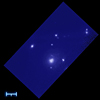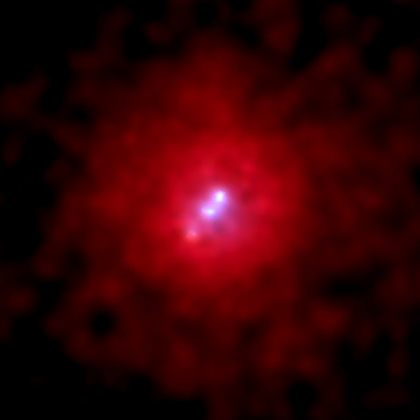Cosmic Payback: Giant Galaxy Reacts to Being Dumped On
3C295 (Cl 1409+524) is one of the most distant galaxy clusters observed by X-ray telescopes. The cluster is filled with a vast cloud of fifty million degree gas that radiates strongly in X rays. It has a redshift of 0.461, which means that we see the galaxy cluster as it was 4.7 billion years ago. 3C295 was first discovered as a bright source of radio waves. The source of the radio emission was found to be a giant elliptical galaxy located in the center of the cluster of galaxies. Chandra discovered that this central galaxy is a strong, complex source of X rays.
| Multi-wavelength Images: (*Images not to scale) | ||
|---|---|---|
X-ray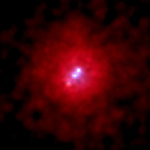 NASA/CXC/SAO NASA/CXC/SAOJpg (87 k) Tiff (1.6 M) PS (3.4 M) |
Optical
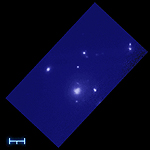 NASA/HST/A.Dressler
NASA/HST/A.DresslerJpg (80 k) Tiff (1.1 M) PS (3.4 M) |
Radio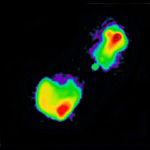 NRAO/AUI/NSF/ R.Perley & G.Taylor Jpg (38 k) Tiff (1.5 M) PS (3.5 M) |
|
||||||||||||||||||||||||||||
This is an X-ray image of the galaxy cluster 3C295. The dominant colors in the image are red and black, with two bright white-blue spots in the center of the image, like a pair of crooked eyes, and a dimmer white spot below left. The structure of the galaxy cluster 3C295 appears to be shaped like an irregular circle, with a brighter central region fading to dark around the edges. The texture is clumpy and mottled. This Chandra X-ray Observatory image of 3C295 shows an explosive galaxy embedded in a vast cloud of hot gas. This cloud, which contains over a hundred galaxies, is more than two million light years in diameter and has a temperature of fifty million degrees. The X-rays from the central galaxy are concentrated in three bright knots that form a line. The central knot coincides with the center of the galaxy; these X rays are probably produced by matter falling into a supermassive black hole. The upper and lower knots are in the same location as two large lobes of radio emission. The distance from the top to the bottom knot is about 100,000 light years, comparable to the diameter of our Milky Way galaxy.



